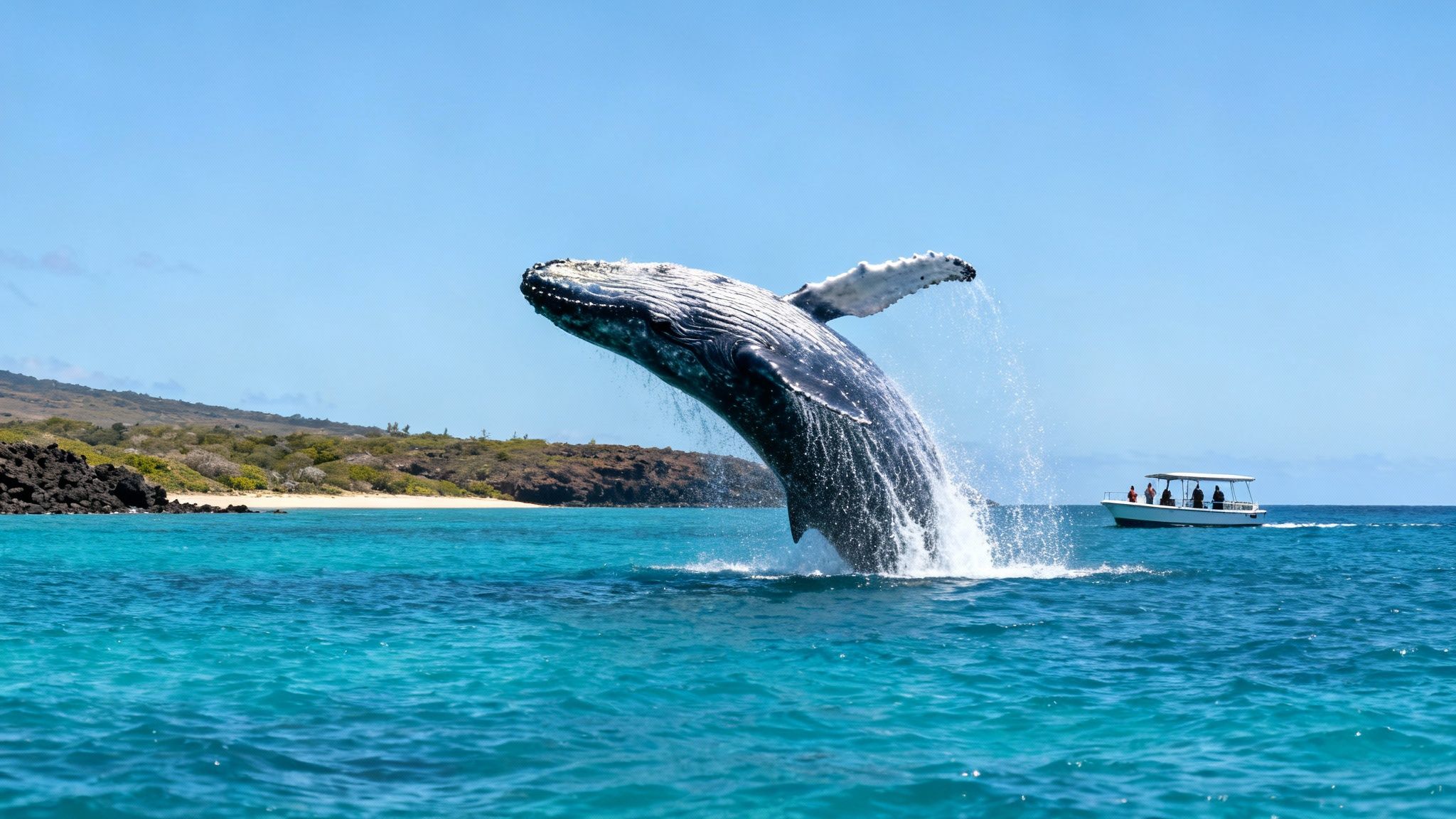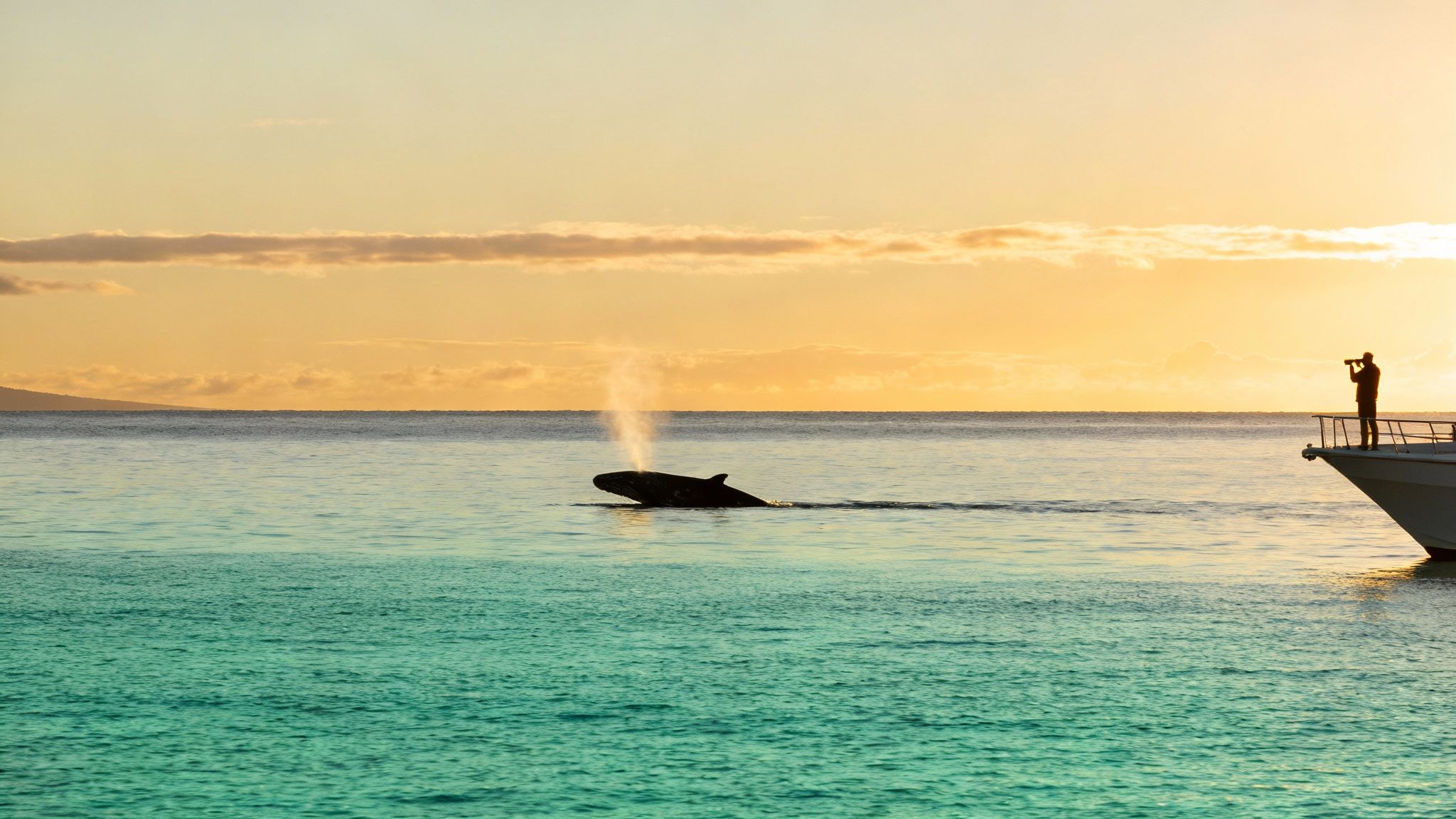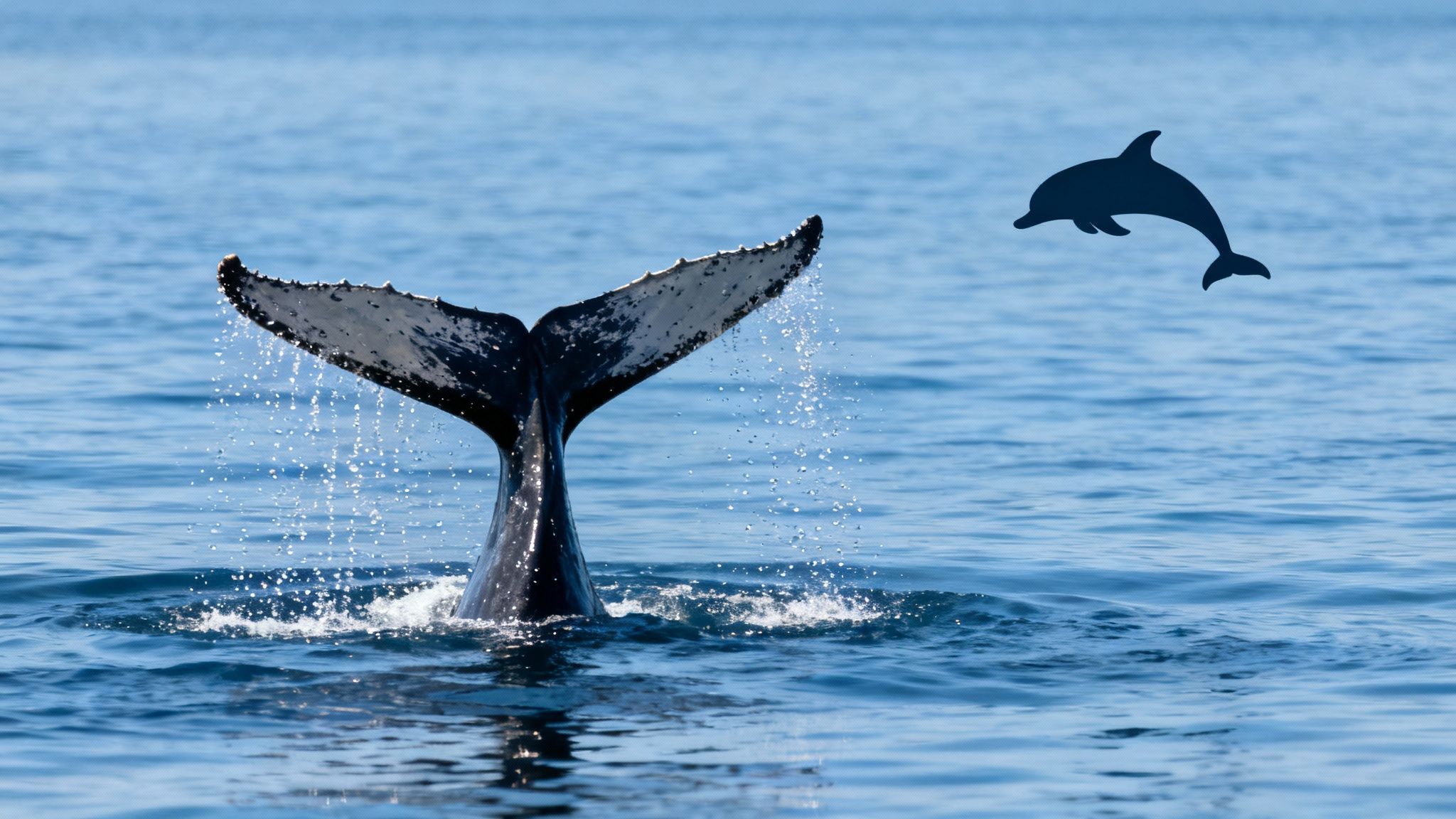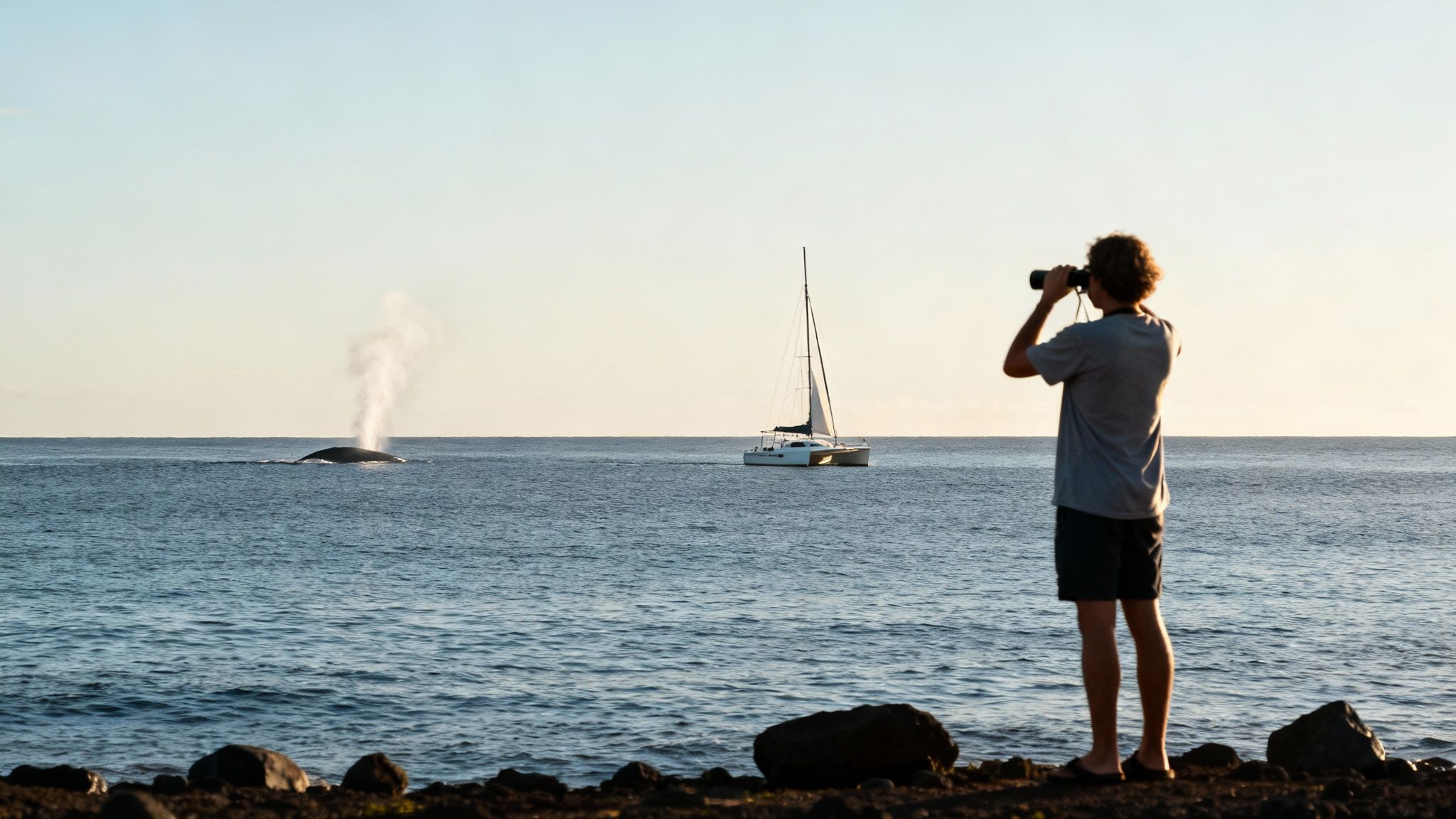whale watching kailua kona: Your Kailua-Kona Guide

Picture this: the brilliant turquoise water off the Kona coast suddenly explodes as a 40-ton humpback whale throws itself completely into the air. This isn't some scene from a nature documentary—it's a very real, and surprisingly frequent, sight during peak season for whale watching in Kailua-Kona, one of the absolute best places on the planet to see these gentle giants.
If you're planning an adventure, you've come to the right place. This guide has everything you need to know.
Witnessing Giants in Kona's Waters
Kailua-Kona is so much more than just a stunning tropical spot; it’s a critical sanctuary for the North Pacific humpback whale population. Every single year, thousands of these incredible animals make a staggering 3,500-mile trek from their chilly feeding grounds up in Alaska. Their destination? The calm, warm, and protected waters right here along the Kona coast.
This massive annual migration is all about the fundamentals of life. They come here to mate, to give birth, and to nurse their newborn calves in a safe harbor, far away from the predators they face in colder seas. The Big Island's unique underwater landscape, with its deep offshore waters just a stone's throw from the coast, makes it the perfect nursery.

Why Kailua Kona Is an Ideal Spot
The conditions we have here create the perfect stage for some of the most jaw-dropping whale behaviors you'll ever see. The seas are often incredibly calm, thanks to the shelter provided by the massive volcanoes, Mauna Loa and Hualalai. This tranquility makes for clearer sightings and a much more comfortable, enjoyable experience out on the water for us humans.
When you head out on a whale watching tour in Kailua-Kona, you're not just a tourist with a camera. You're getting a front-row seat to a crucial chapter in the life of these amazing animals.
To really make the most of it, you’ve got to go with a top-rated crew that knows these waters and respects the wildlife. Kona Snorkel Trips has earned its reputation as Hawaii's top rated & most reviewed snorkel company for a reason. Our expert guides live and breathe this stuff, and our commitment to small group sizes means you get a personal, unforgettable adventure. It's about connecting you directly with the magic of Kona's marine world.
When to Go for Peak Whale Encounters
If there's one secret to an absolutely mind-blowing whale watching trip in Kailua-Kona, it's timing. Getting it right means understanding the whales' schedule, not ours. Their annual trip here is one of the most incredible journeys in the natural world, and we're lucky enough to have front-row seats.

Every year, the waters off the Kona coast become a vital sanctuary for a massive migration. We're talking more than 8,000 humpback whales traveling a staggering 3,500 miles from their chilly Alaskan feeding grounds. They come to Hawaii's warm, protected waters to breed, give birth, and nurse their new calves.
This epic pilgrimage turns Kona into a global hotspot for whale activity. It's a truly special phenomenon, and if you want to dive deeper, you can learn more about the Big Island whale season in our guide.
Pinpointing the Peak Season
Officially, the whale season here runs from mid-December through March. But let me tell you, the action really ramps up as the weeks go by. While you can definitely spot whales throughout that whole window, the absolute peak months are January and February.
During this time, the ocean just comes alive. The density of whales is at its highest, which means your chances of seeing the really dramatic stuff—breaching, tail slapping, and pectoral fin waves—skyrocket. It's not uncommon for local research counts to spot an average of 3 to 6 humpback whales every 15 minutes in prime areas around the Big Island. That's a lot of whales!
Expert Tip: Planning your trip for January or February puts you right in the heart of the action. This is when you're most likely to see the powerful competition pods of males vying for a female's attention and those tender, unforgettable moments between a mother and her newborn calf.
Month-by-Month Whale Activity
To help you sync your vacation with the best possible encounters, it helps to know what to expect month by month. The first arrivals in December kick things off, the population swells to its max in the dead of winter, and then it tapers off as they start the long trek back north in the spring.
Here's a quick look at what the season typically looks like.
Kona Whale Watching Season Month-by-Month
| Month | Whale Activity Level | Typical Behaviors Observed |
|---|---|---|
| December | Low to Moderate | The first arrivals appear. You'll mainly see solo whales or small groups, with occasional spouts and fluke dives as they settle in. |
| January | High | Activity ramps up quickly. More frequent sightings, with competition pods forming. Breaching and tail slapping become more common. |
| February | Peak | The highest concentration of whales. This is prime time for seeing mothers with newborn calves, plus intense surface activity from males. |
| March | Moderate to High | Still a fantastic month! The population starts its gradual decline, but plenty of mother-calf pairs remain, often seen resting. |
| April | Low | The season is winding down. You might still catch a few late departures, but sightings become much less frequent as they head back to Alaska. |
Choosing the right month really does shape your experience. Whether you're hoping for the high-energy drama of peak season or the quieter moments of the early and late weeks, knowing the rhythm of the migration is key.
Understanding Whale Behaviors and Local Wildlife
A whale watching tour in Kailua-Kona is so much more than just spotting a distant puff of water on the horizon; it’s like learning the secret language of the ocean. Seeing a humpback is one thing, but knowing what it’s doing completely elevates the experience from a simple sightseeing trip to a profound connection with these gentle giants.

Every single action has a purpose, from those breathtaking displays of power to the more subtle forms of communication. Once you know what to look for, the entire ocean becomes a story unfolding right before your eyes.
Decoding Common Humpback Behaviors
Out on the water, you'll witness a whole range of behaviors that are as meaningful as they are spectacular. Here are a few of the most common displays you might see and what they could mean:
- Breach: This is the one everyone dreams of—the iconic, full-body leap clean out of the water. Whales might do this to talk to others miles away, shake off annoying skin parasites, or maybe just because they feel like it!
- Tail Slap (Lobtailing): A powerful smack of the tail on the water's surface sends a massive splash and a loud boom that travels for miles underwater. Think of it as a warning shot or a way of saying, "Hey, I'm over here!"
- Pectoral Fin Slap: You'll see a whale roll onto its side and just repeatedly slap its long fin against the water. It’s another way they communicate, likely signaling to other whales in the area.
- Spyhop: When a whale pokes its head straight up out of the water, it's called a spyhop. This is pure curiosity. They're getting a better look at their surroundings above the surface—and that includes you and your boat.
- Spout (Blow): This is the classic whale watching sight, but it's really just the whale breathing out. That misty spray is a mix of water, mucus, and air, and it blasts from their blowholes at over 300 miles per hour!
Kona's Diverse Marine Wildlife
While the humpbacks are definitely the main event, they rarely travel alone. Kona's deep offshore waters are like a bustling city for marine life, and it's totally normal to meet other fascinating locals on your tour.
The humpbacks you see near Kailua-Kona are part of a special Hawaiian breeding group, but the biodiversity is incredible. You might also spot false killer whales (we have an estimated 150-200 individuals in Hawaiian waters) or even huge pods of melon-headed whales.
Keep an eye out for pods of playful spinner dolphins, which often love to leap and twist right in the boat's wake. You might also catch a glimpse of oceanic whitetip sharks, pilot whales, and every once in a while, the elusive sperm whale.
To really get the most out of what you’re seeing, exploring other nature and wildlife experiences can seriously deepen your connection to this amazing environment. Recognizing these different animals and what they're up to transforms your tour into a rich, immersive natural history lesson on the water.
Choosing the Right Whale Watching Tour
Picking the right tour is probably the most important call you'll make for your whale watching Kailua Kona adventure. Seriously. The boat you're on and the crew leading the way will completely define your experience, taking it from just a "good day" to something you'll talk about for years. Let's break down the options so you can find the perfect fit.
The first big decision you'll face is the type of boat. Each one offers a totally different vibe and its own set of perks.
Comparing Vessel Types
What you prefer really comes down to stability, how many people you want to share the view with, and how close you want to be to the water.
- Large Catamarans: Think of these as the big, steady platforms of the sea. They're known for a smooth ride and usually come with plenty of comforts like shaded seats, restrooms, and maybe even a snack bar. This makes them a fantastic choice for families with little ones or anyone who gets a bit queasy on the water.
- Small Zodiac-Style Boats: These are your rigid-hulled inflatable boats (or RIBs), and they offer a much more thrilling, up-close-and-personal trip. You're lower to the water, giving you a really unique, eye-level view of the whales. They're also fast and nimble, so they can cover a lot of ocean, but be prepared for a bumpier, more adventurous ride.
As a general rule, the bigger the boat, the bigger the crowd. If you're after a more intimate connection with the ocean and don't want to be jockeying for a spot at the railing, a small-group tour is almost always the way to go.
The Value of an Expert Crew
Okay, beyond the boat itself, the single most critical piece of the puzzle is the crew. A trip led by a seasoned captain and a marine naturalist is a world away from a simple boat ride where someone just points and says, "There's a whale." These guides make the ocean come alive.
An expert crew brings so much to the table:
- They Know What You're Seeing: They can explain the whale behaviors as they happen, share incredible facts about humpback biology, and answer all those questions that pop into your head.
- They Find Whales the Right Way: Their experience lets them spot subtle signs of whale activity and position the boat for a great view without stressing out the animals. It's all about respect.
- They Make the Day Better: They'll share stories, point out other cool marine life you might have missed, and help you build a real appreciation for Kona's entire marine ecosystem.
This is what turns your trip from just watching into a genuine, engaging experience. It’s the difference between simply seeing a whale and starting to understand its world.
This is exactly where operators like Kona Snorkel Trips shine during the season. We focus on small groups because we believe it creates a more personal and powerful encounter. Our guides aren't just boat drivers; they're passionate naturalists dedicated to giving you a safe, respectful, and truly moving experience with Kona's gentle giants. You can check out the different kinds of whale watching tours in Kona Hawaii to find the one that feels right for you.
Shore Viewing Versus a Boat Tour Adventure
Can you have a fantastic whale watching experience in Kailua-Kona without ever setting foot on a boat? Absolutely. Watching from shore is a perfectly valid option, especially if you're on a budget or just prefer to stay on solid ground. But I'll tell you, it's a completely different world from being out on the water.

Each approach has its own vibe, its own pros and cons. Think of it as choosing between quiet, distant admiration and an up-close, immersive encounter. Understanding the difference will help you pick the right adventure for your trip.
The Land-Based Perspective
Spotting whales from the coastline is really an exercise in patience and perspective. The biggest plus is obvious: it’s totally free, and you can do it whenever you want. All you really need is a decent pair of binoculars, a comfy spot to sit, and a little bit of luck.
Prime Shore Viewing Spots:
- Puʻukoholā Heiau National Historic Site: This spot, just north of Kona, gives you some elevation over the ocean, which makes spotting those tell-tale spouts much easier.
- Kapaʻa Beach Park: Another fantastic location with wide-open ocean views, perfect for scanning the horizon.
- Kekaha Kai State Park: The rugged coastline here is beautiful on its own, and it provides a stunning backdrop for your whale search.
The main drawback is simply distance. From the shore, you’re looking for misty spouts and maybe, if you're lucky, a breach way out on the horizon. It's still a thrill, but you miss out on the subtle behaviors and the true, mind-boggling scale of these animals.
The Immersive Boat Tour Experience
Getting out on the water is where the real magic happens. A boat tour doesn't just get you closer; it puts you right in the middle of the whales' world. The whole experience shifts from just something you see to something that hits all your senses.
The most profound difference is the sound. From a boat, you can actually hear the powerful whoosh of a whale's breath as it surfaces. It’s a sound that connects you to the animal in a way that’s impossible from miles away on shore.
On a tour, you’ll see behaviors you'd never catch from land—a curious spyhop near the boat, the complex social dance within a pod. While federal law requires boats to stay 100 yards away, the whales haven't read the rulebook. Often, a curious whale will choose to approach on its own terms, creating those unforgettable, up-close encounters you'll be talking about for years.
For a deeper dive into what these trips are like, check out our guide to whale watching on the Big Island.
Ultimately, while hanging out on shore is a wonderful way to spend an afternoon, a well-run boat tour offers a connection and an educational depth that is simply in a league of its own.
How to Prepare for Your Day on the Water
A little bit of prep work goes a long way. Seriously. Thinking ahead and packing the right stuff is what turns a pretty good whale watching tour into an absolutely unforgettable one. When you're comfortable and ready, you can just relax and soak in the magic of the moment without worrying about anything else.
Your day should be all about the whales, not about a nasty sunburn or a queasy stomach.
What to Pack for Your Whale Tour
Packing smart is the name of the game. The weather out on the open ocean can shift in a heartbeat, so a few key items will make all the difference. Think layers, and think sun protection.
- Reef-Safe Sunscreen: This is a must. The Hawaiian sun is no joke, and we need to protect both our skin and the fragile coral reefs below.
- Polarized Sunglasses: These are a game-changer. They do more than just shade your eyes; they cut right through the water's glare, making it way easier to spot a spout or a tail fin breaking the surface.
- Light Jacket or Windbreaker: Even on the warmest Kona days, the breeze on the water can have a surprising chill. A light layer is perfect for staying comfortable.
- Camera with a Good Zoom: You'll want to capture those incredible breaches and tail slaps. A zoom lens lets you get those amazing shots while keeping a respectful distance from the whales.
- Hat and Reusable Water Bottle: Simple, but essential. Stay hydrated and keep the sun off your face.
Staying Comfortable at Sea
If you get motion sick sometimes, don’t let that stop you from having this incredible experience. A few simple tricks can work wonders. You might consider an over-the-counter remedy—just be sure to take it before you leave the dock as directed. Staying hydrated and focusing your gaze on the stable horizon line can also be a massive help.
Beyond the gear, the right mindset is just as important as anything in your backpack. Reading up on making the most of an adventure can get you in the perfect headspace. When you show up prepared, curious, and open to whatever the ocean has in store, you’re setting yourself up for an incredible day with Kona’s gentle giants.
Your Kona Whale Watching Questions Answered
We’ve gone over the what, when, and where of planning your whale watching adventure, but it’s totally normal to have a few more questions rattling around before you pull the trigger. Let's tackle some of the most common things people ask before booking a whale watching Kailua Kona tour so you can feel confident and ready to go.
Is a Whale Sighting Guaranteed on a Tour?
This is probably the number one question we get, and the honest answer is no. We're talking about wild animals in their massive ocean home, and no ethical, reputable tour operator can ever promise you'll see them. It just wouldn't be right.
That said, your chances are incredibly high. Experienced captains in Kona know these waters like the back of their hand. During the peak months of January and February, success rates are often well over 90%. The thrill of the search, scanning the horizon for that first puff of mist from a blowhole, is a massive part of the magic.
How Close Can Tour Boats Get to the Whales?
To keep the humpbacks safe and sound, especially the new moms and their calves, strict federal regulations are in place across all of Hawaii. Every single boat, from the zippy little rafts to the big catamarans, has to stay at least 100 yards away. Think of it as the length of a football field.
This buffer gives the whales the space they need to go about their business without feeling stressed. The absolute best encounters happen when a curious whale decides to check us out. When a 40-ton animal decides to surface near the boat on its own terms, it's a moment you'll never, ever forget.
What Is the Best Time of Day for Whale Watching?
Honestly, there's no secret "best" time. Whales are active throughout the day, so it really boils down to your personal preference and what kind of experience you're looking for.
Morning trips often have the advantage of calmer seas and beautiful, soft light that's perfect for photos. On the flip side, some people feel the whales are a bit more active and playful in the afternoons, leading to more surface action like tail slaps and breaches. The most important thing isn't the time on the clock, but simply being out on the water during the peak season when the highest number of whales are in town.
What Can I Do Outside of Whale Season?
No whales? No problem! Kona's underwater world is a year-round spectacle. While the humpbacks are our celebrated winter guests, there are incredible adventures waiting for you any time you visit.
One of the most mind-blowing experiences on the planet is the Manta Ray Night Snorkel tour, where you can float just feet away from these gentle giants as they dance and feed. Another can't-miss trip is a Captain Cook Snorkeling Tour to the pristine, protected waters of Kealakekua Bay, famous for its crystal-clear visibility and vibrant coral reefs.
Ready to make some memories? Kona Snorkel Trips specializes in small-group, expert-led tours that get you up close with the best of the Big Island's marine life. Book your adventure today!
